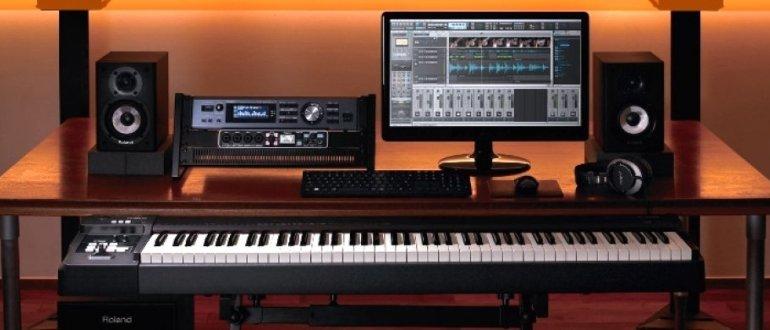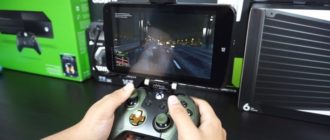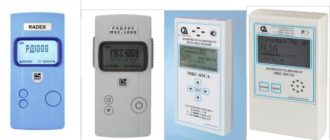A personal computer has already turned one and a half decades ago from an ordinary workstation into a full-fledged device designed to work with multimedia files. In addition to visiting sites and chatting on social networks, this equipment can be used to watch videos, listen to music, process audio, games and so on.
To fully output the signal to headphones or speakers, the computer is necessarily equipped with a sound card. Many novice musicians use a computer to record their tracks. For this, special sound cards are designed, the parameters of which are significantly higher than the user ones. Unfortunately, not all people know exactly which sound card is suitable for recording voice or music in a certain direction. Today we decided to fill this gap by rating the best sound cards for the 2019 home studio.
Before starting a direct analysis of the useful characteristics of specific models, let's figure out what to look for when buying this equipment, especially since there is a very wide selection of similar devices on the shelves of computer equipment stores. With this we will begin our review.
Summary of the rating:
How to choose a sound card?
The key task of this element of a personal computer is to convert a digital signal into an analog one, followed by transferring it to headphones or speakers. Almost all motherboards have an integrated sound card, but its power may not be enough to make a full sound recording. In addition, the integrated device will adversely affect the overall performance of the personal computer.
More and more users are inclined to purchase an external sound card that will connect to a computer or laptop using a special high-speed interface called FireWire. Due to this solution, it is possible to significantly reduce interference, which positively affects the sound quality.
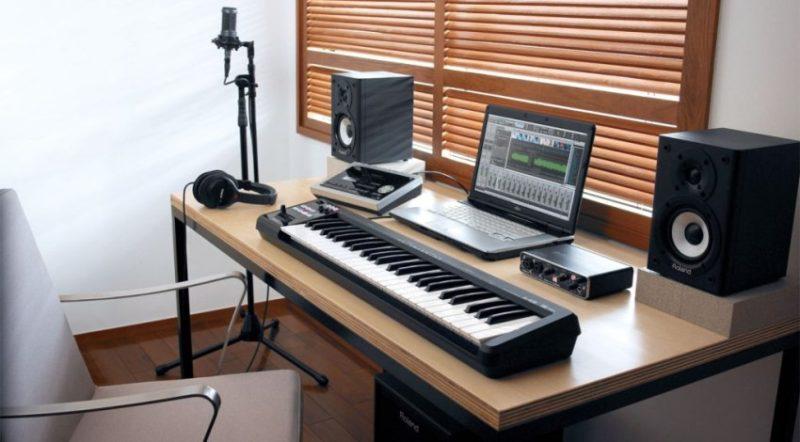
Currently, there are two similar standards - IEEE 1394, which provides bandwidth at 400 Mbps, and IEEE 1394b - it has a data transfer rate of about 800 Mbps. There are also external sound cards that can be connected to a computer via a traditional USB connector. Such products usually provide access to speakers or headphones, as well as the ability to connect one or more microphones. Unfortunately, their maximum bandwidth does not exceed 480 Mbps - this may not be enough for professional sound recording.
On sale you can find more powerful studio sound cards. Their main distinguishing feature is the presence of a large number of various outputs that can be used to connect a wide variety of musical instruments: electric, acoustic and bass guitars, microphones, synthesizers and so on. In addition, such devices are capable of high-quality sound from a drum kit.One of the distinguishing features of such products is the lack of the need to install drivers, however, you still have to install the software. It will be very useful when working with the equalizer and other settings.
When choosing models to include in our rating of the best sound cards for studio recording, we were guided by all these parameters, however, we also took into account user reviews, including professional sound engineers and musicians, and also took into account the price-quality ratio. We tried to include not too expensive models in the rating so that each of our readers could afford to buy this equipment. Now is the time to analyze the useful characteristics of such products.
Ten Studio Sound Card Models
10. Lexicon Alpha
![]()
By and large, this device is not a sound card, but a full-fledged studio designed for sound recording and dubbing of films. The model has multidisciplinary software. A USB mixer and a special Lexicon Pantheon reverb plug-in are provided. It also has one XLR microphone input, TRS and RCA inputs and outputs. On the front panel, the user will find a quarter-inch instrumental universal input, allowing direct recording to a personal computer. In addition there is a headphone jack. In general, the operating parameters are quite modest, but the price of the device is also quite reasonable, so the model is perfect for use at home.
The design has a robust case made of silver and blue plastic with a matte finish, which gives the product additional style. The handles are also plastic, grooved, rotate quite smoothly and moderately tight, which allows you to set the most accurate parameters. A fairly long USB cable is supplied with the sound card, drivers will still have to be installed, otherwise the computer may not see such an external device. In addition, this process has a positive effect on the overall performance of the equipment.
Benefits:
- To work in the home studio provides a pretty decent sound quality;
- All adjustments are mechanical, which allows you to adjust to the specific acoustic characteristics of the room, change the parameters directly in the recording process;
- There are all the necessary connectors for connecting microphones and musical instruments;
- You can record voice at the same time as music.
Disadvantages:
- When working with a microphone connected via the XLR connector, recording is only in mono mode.
9. Fosusrite Scarlett Solo
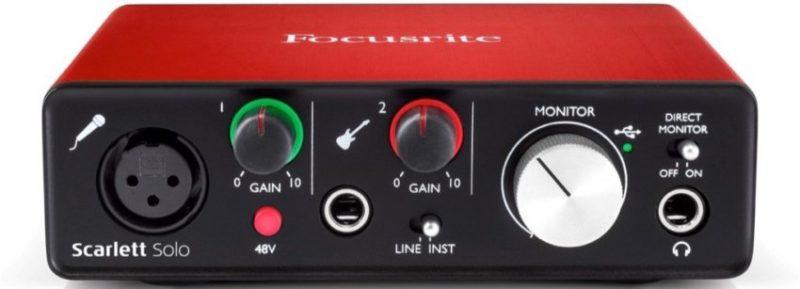
Fairly easy to use and very small-sized device, providing high quality sound recording even at home. You can work with it on various platforms - MacOS and Windows. If necessary, the sound card can work completely offline, that is, without connecting to a personal computer. You can take this model with you everywhere: just connect it through a special connector to the mains, connect it to a microphone and a guitar, and then start recording. Interfaces are optimal for working with any musical equipment. If necessary, the instrumental part and vocals can be recorded simultaneously. In addition, there is a function for activating effects - impose amplifiers on the guitar channel, as well as add reverb to the vocals.
The audio output delay is minimal. The user can download special software for the products, so the customization options will be greatly expanded. There are various overdrive, plugins, amplifiers and other additions. Initially, this model was developed exclusively for guitarists, however, musicians playing keyboards or drums will be able to appreciate the capabilities of such a sound card.
Benefits:
- The minimum time delay of the output signal;
- Superior sound quality
- All physical controls are carefully thought out;
- When various effects are activated, special LEDs will light up.
Disadvantages:
- The software does not always work correctly;
- The sound in the headphones is somewhat flat.
8. Zoom UAC-2
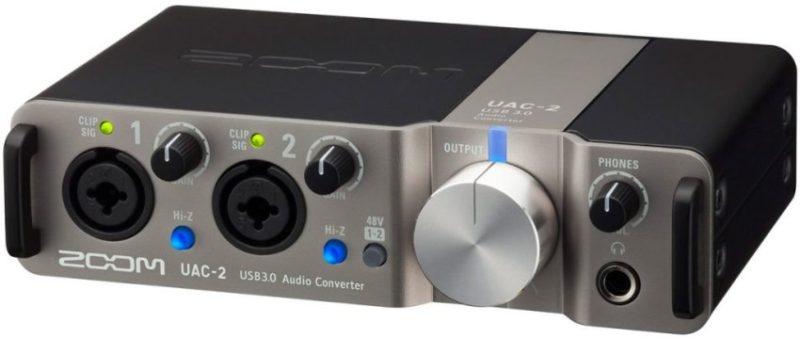
It has a fairly high speed, this sound card can use two channels at once, and the interface was originally created for optimal use on MacOS and Windows platforms. With the help of these products it will be possible to bring the quality of the recorded sound to a whole new level. Connects to USB 2.0 or USB 3.0, can work with various mobile devices. When developing products, the most advanced SuperSpeed technology was used, with which it was possible to achieve a minimum delay in the output signal. In addition, there is a whole set of advanced features, in particular, fourfold upsampling. Absolutely any musical instrument, microphone or other linear signal source can be connected to the sound card.
The card is suitable for playing music from the scene, it can be used as a full-fledged digital workstation, aimed exclusively at listening. The interface is suitable for making online media presentations, game broadcasts, and so on. The sound card can work with any microphones, starting with the simplest and ending with professional ones. The housing has a connector for direct connection to a household electrical outlet.
Benefits:
- Fairly strict appearance;
- Build quality implies solidity of the case;
- It is very convenient to use;
- The interface functions stably regardless of the platform used;
- All inputs and adjustment knobs are located on the front panel of the product;
- The drivers are reliable, updated rarely enough;
- You can work without connecting to a personal computer.
Disadvantages:
- When you turn off the computer, it still continues to work.
7. Steinberg UR44
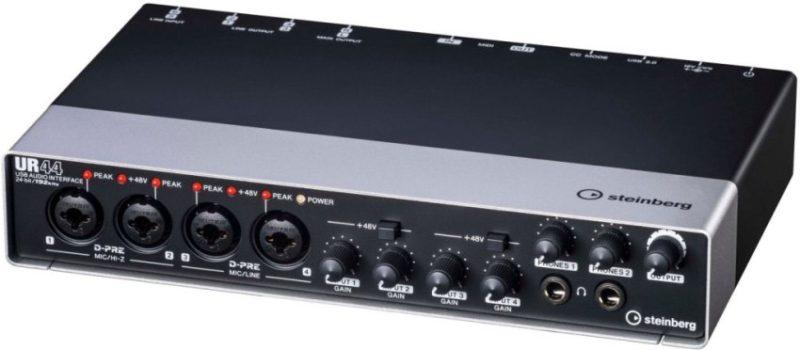
Despite the fact that this product was developed and released about five years ago, today there are not too many models of studio sound cards that could surpass it in the field of operational parameters. There are four inputs for connecting microphones at once, so it will be possible to record several vocal tracks. The case is made entirely of metal, but this does not affect the quality of the recorded music in any way - nothing is screened, the depth and fullness of the sound will not be lost. The sound card is capable of operating in modes up to 24 bits at a frequency of 192 kHz. XLR / TRS connectors combined. Like all the models that we examined earlier in this review, this sound card is equipped with its own software. The application installed on a personal computer is a control panel that can control the built-in hardware mixer.
Each channel has several built-in effects - equalizer, compressor. The first is equipped with a set of factory settings, and they can be adjusted and returned to their original position. The program allows you to create your own settings when working with the equalizer, as well as save them. The reverb function here is designed more for concert rather than studio use. All control elements are located on the front of the equipment. No display or sub menu is provided here. The interface is also equipped with microphone preamps.
Benefits:
- As many as four microphone inputs;
- It works stably even in the latest versions of the Windows operating system;
- It can also be connected to a working personal computer;
- Extended functionality of the mixer and processor that controls effects;
- The frequency range, if necessary, can be adjusted in real time.
Disadvantages:
- Microphone outputs are not galvanically connected;
- Not suitable for listening to music;
- Fairly high cost.
6. PreSonus Studio 24

This is one of the latest studio sound cards that appeared on the market not too long ago - about six months ago. The model is perfect for home and semi-professional use. The device has two combined inputs, each of which is equipped with an XMAX-L preamplifier, in addition, there are two linear TRS outputs and an output for connecting headphones. The case is made of high-quality plastic with a matte finish - all kinds of pollution and dust will not accumulate on it. It is distinguished by a solid assembly: all elements are reliably fitted to each other, no backlashes and extraneous creaks were detected even with strong pressure.
All the regulators responsible for signal amplification are located on the front panel, there is also a button for turning on phantom power. One of the important qualities is the presence of a liquid crystal display that displays the input levels. The dynamic range of the converters is 108 dB. The sound card comes complete with specialized Studio One Artist software, which includes several additional plug-ins. It is connected to a personal computer using USB C / A cables.
Benefits:
- A compact model that requires a minimum amount of free space, which makes it ideal for home use;
- Ergonomic location of inputs and outputs, as well as adjustment knobs;
- There is a direct monitoring function;
- It is powered through the connector
Disadvantages:
- Pretty heavy device;
- Headphone output is located on the rear panel.
5. Apogee Duet
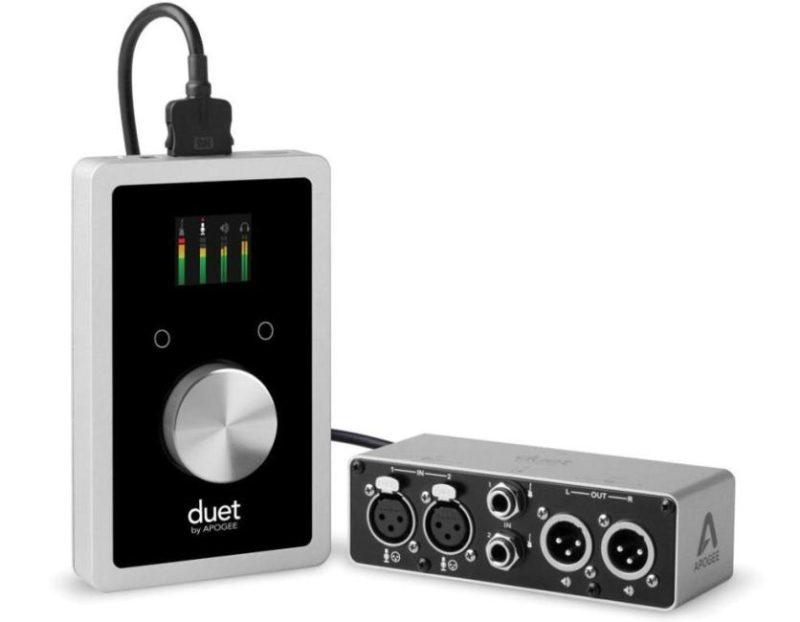
It is characterized by small overall dimensions and weight, so this sound card can be easily taken with you on a trip or on a business trip. According to representatives of the company that developed this equipment, this product is the first professional model equipped with direct digital connection technology to Apple products. In addition, it is able to work with MacOS and Windows platforms. The sound card operates with the help of special Apogee Maestro software, with the help of which the user will constantly control the sound coming through the inputs and outputs of the products.
The sound card has a built-in battery. Mobile devices will charge when working with it, so you don’t have to worry about the gadget being discharged at the most inopportune moment, and you will not be able to save operating time. It is connected to a personal computer via the USB 2.0 interface. On the front panel you can find two analog inputs and four analog outputs, there are two microphone preamps. On the front panel is a high-definition liquid crystal display, there are also two programmable touchpads.
Benefits:
- Small weight and dimensions;
- Compatibility with mobile devices running on the iOS platform;
- Thoroughly thought out software.
Disadvantages:
- High price;
- Not too easy to find on sale.
4. Universal Audio Apollo Twin MKII DUO
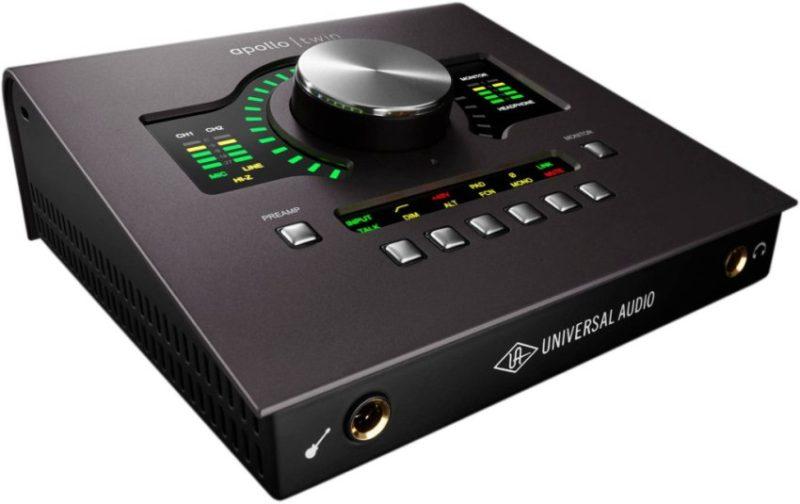
This model has been on the market for studio sound cards for about two years. This is the latest generation of such equipment that uses analog-to-digital and digital-to-analog signal converters, due to which it is possible to ensure the highest possible sound quality, including at home. This device has fairly decent monitoring capabilities, and a built-in talkback microphone is provided. The sound card operates on the basis of the Thunderbolt 2x6 interface, which is supported by the Windows and MacOS operating systems, in addition, it is equipped with the latest generation converters - in the two years since its release, nothing was better invented.
All hardware buttons are located on the top panel, which also has a rotary frequency control. There are two liquid crystal displays. The case is made of high quality plastic. Its upper side has a matte finish, the edges are glossy. The overall dimensions are not too large, so the products will be very convenient to use, including far from home.
Benefits:
- Very stylish and attractive appearance;
- It has all the features for high-quality work with sound of any type;
- A built-in microphone is provided;
- The assembly is quite reliable, no creaks and backlashes were detected.
Disadvantages:
- There are not too many plugins as standard, they will have to be purchased separately;
- The product itself is of high cost.
3. REM Fireface UCX
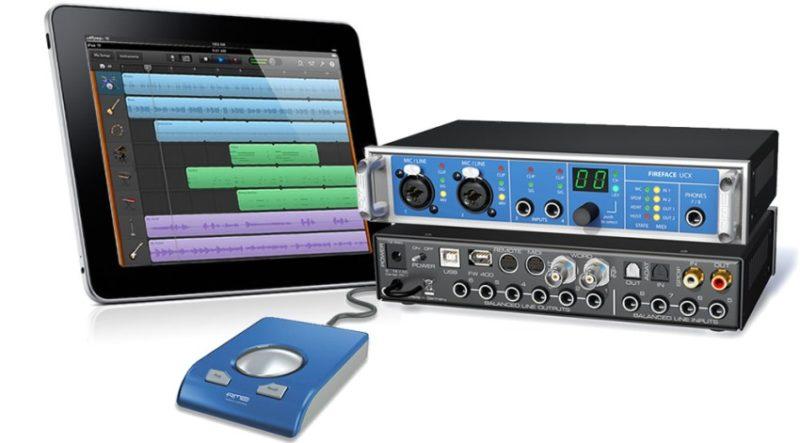
Finally, we got to the top three of our today's ranking of the best studio sound cards of 2019, designed for home or semi-professional use. In general, recently, experienced users in this regard can hardly surprise anything, but they were able to perceive and appreciate the operational characteristics of this product. In terms of the number of connected cables, the model is practically no different from real professional equipment. A remote control is included with the product, so you can manage products from a distance. Connects via USB 2.0 or FireWire.
The design is equipped with a large number of state-of-the-art converters, which provide the minimum level of noise and sound distortion. The delay time is minimal. The sound card is able to work with the TotalMix application, which provides a slight delay, and also allows for convenient routing. This model also has increased hardware processing, which is usually installed on the most powerful sound cards installed in high-end studios. Up to six user settings can be stored in the product firmware; they are called up by a special control button located on the front panel of the equipment.
Benefits:
- Excellent quality of recorded sound;
- Small overall dimensions;
- A decent amount of inputs and outputs.
Disadvantages:
- If you use the device for a long time and continuously, then it starts to get quite hot;
- High price.
2. MOTU UltraLite-mk4
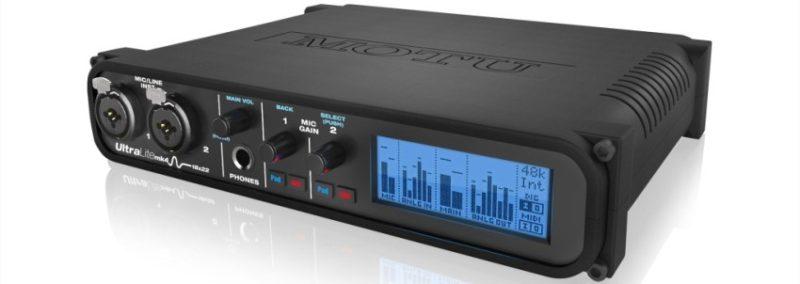
Quite an interesting and original model, which was awarded second place due to decent functionality. From the rear there are many analog inputs and outputs - eight pieces of each type at once. At the same time, on the front side you can find several knobs and toggle switches to control sound quality and channels. There is also a liquid crystal display. It is quite simple, but at the same time informative, it has a nice LED backlight that allows you to work with the device even with a lack of lighting. This sound card is powered by a special adapter, or by FireWire 400, the possibility of connecting power via the USB connector is not provided. If the user plans to use FireWire, then there is no need to provide any more connection - power and data will be transmitted via one cable.
The device is characterized by excellent build quality, the sound as a result is quite clean, no cracks and noises were found during operation. You can control the sound card using a special graphical interface. If necessary, the equipment is allowed to be used offline, without connecting to a computer. In other words, the card will act as a separate switching unit.
Benefits:
- High level of reliability;
- FireWire and USB interfaces are provided immediately;
- The minimum indicator of sound delay;
- The output is a clean and high-quality sound, without the slightest hint of noise and distortion;
- Very user-friendly graphical interface;
- You can use the sound card offline.
Disadvantages:
- There is only one headphone jack;
- There is no possibility of power via the USB interface.
1. RME Babyface PRO
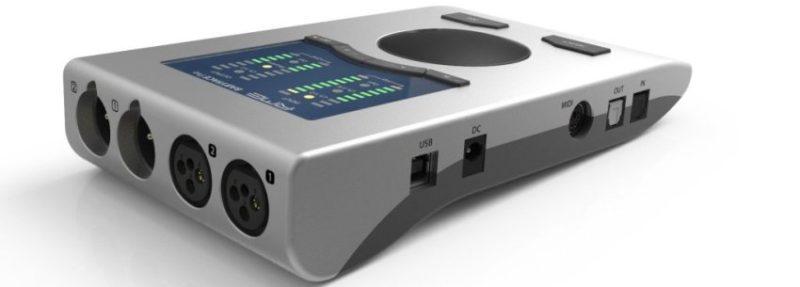
We are pleased to introduce the first place winner - an external portable sound card made in Germany, which is distinguished by its compact overall dimensions and quite powerful sound. It is crystal clear, not a single user has noticed the slightest hint of distortion of sound and could not hear the noise. The device is placed in a small case made of high-strength cast aluminum alloy. Although the thickness of the metal is small, the case is very durable, so it is able to withstand significant physical stress. This material does not shield the sound, so it will not affect the sound quality at all. The model is connected via the USB 2.0 connector.
Thanks to the connection of an external ADAT converter, you can use a very large number of analog channels: a total of 24 - 12 for input and output lines. This equipment is perfect for professional concert or studio activities. Many musicians purchase it for home use. The product has support for sampling frequencies up to 192 kHz, a switchable phantom power is provided. Microphone amplifiers are equipped with a gain of not more than 70 dB, and the step is only 3 dB. The control here is digital, so you can easily set the exact value of any parameter.
Benefits:
- Excellent sound quality and high detail throughout the frequency range;
- Minimum overall dimensions of the device;
- The metal case of increased strength;
- It can be used for both concert and studio activities, including for working at home;
- The inputs and outputs are completely independent of each other.
Disadvantages:
- High price;
- Each platform will have to download its own drivers.
In conclusion, a useful video
Our rating of the best sound cards for studio work has come to an end. We hope that the information collected by us will be quite enough for you so that you can choose the best product for yourself. If you still have some doubts, or if you want more information about a particular model, feel free to comment in the comments. We will try to quickly respond to your comment and provide you with all the additional information, stating them in an accessible format.

